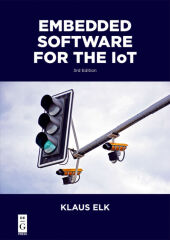 Neuerscheinungen 2018Stand: 2020-02-01 |
Schnellsuche
ISBN/Stichwort/Autor
|
Herderstraße 10
10625 Berlin
Tel.: 030 315 714 16
Fax 030 315 714 14
info@buchspektrum.de |

Klaus Elk
Embedded Software for the IoT
3. 2018. XIV, 280 S. 30 b/w ill., 15 b/w tbl. 240 mm
Verlag/Jahr: DE GRUYTER; DE G PRESS 2018
ISBN: 1-547-41715-3 (1547417153)
Neue ISBN: 978-1-547-41715-5 (9781547417155)
Preis und Lieferzeit: Bitte klicken
With a mixture of theory, examples, and well-integrated figures, Embedded Software for the IoT helps the reader understand the details in the technologies behind the devices used in the Internet of Things. It provides an overview of IoT, parameters of designing an embedded system, and good practice concerning code, version control and defect-tracking needed to build and maintain a connected embedded system. After presenting a discussion on the history of the internet and the word wide web the book introduces modern CPUs and operating systems. The author then delves into an in-depth view of core IoT domains including: Wired and wireless networking Digital filters Security in embedded and networked systems Statistical Process Control for Industry 4.0 This book will benefit software developers moving into the embedded realm as well as developers already working with embedded systems.
Introduction
1.1 The Tale of the Internet
1.2 The Cloud
1.3 Internet of Things
1.4 IoT related terms
I The Basic System
2 How to select an OS?
2.1 No OS and strictly polling
2.2 Co-routines
2.3 Interrupts
2.4 A small real-time kernel
2.5 A non-preemptive Operating System
2.6 Full OS
2.7 Open Source, GNU licensing and Linux
2.8 OS constructs
2.9 Further Reading
3 Which CPU to use?
3.1 Overview
3.2 CPU Core
3.3 CPU Architecture
3.4 Word-Size
3.5 MMU - Memory Managed Unit
3.6 RAM
3.7 Cache
3.8 EEPROM and Flash
3.9 FPU - Floating Point Unit
3.10 DSP
3.11 Crypto-Engine
3.12 Upgrade Path
3.13 Second Sources
3.14 Price
3.15 Export Control
3.16 RoHS-Compliance
3.17 Evaluation Boards
3.18 Tool-chain
3.19 Benchmarking
3.20 Power-Consumption
3.21 JTAG Debugger
3.22 Peripherals
3.23 Make or Buy
3.24 Further Reading
4 Software Architecture
4.1 Design for Performance
4.2 The fear of the white paper
4.3 Layers
4.4 Not just API´s - more files
4.5 Object Model (Containment Hierarchy)
4.6 Case: CANOpen
4.7 Message Passing
4.8 Middleware
4.9 Case: Architectural Reuse in LAN-XI
4.10 Understanding C
4.11 Further Reading
5 Debug Tools
5.1 Simulator
5.2 ICE - In-Circuit-Emulator
5.3 Background or JTAG debugger
5.4 Target Stand-In
5.5 Debugger
5.6 strace
5.7 Debugging without special tools
5.8 Monitoring Messages
5.9 Test Traffic
6 Code Maintenance
6.1 Poor Man´s Backup
6.2 Version Control - and git
6.3 Build and Virtualization
6.4 Static Code Analysis
6.5 Inspections
6.6 Tracking Defects & Features
6.7 Whiteboard
6.8 Documentation
6.9 Yocto
6.10 OpenWRT
6.11 Further Reading
III IoT Technologies
7 Networks
7.1 Introduction
7.2 Cerf & Kahn - internet as net of nets
7.3 Life of a packet
7.4 Life before the packet
7.5 Getting an IP address
7.6 DHCP
7.7 Network Masks, CIDR and Special Ranges
7.8 Reserved IP-Ranges
7.9 DNS
7.10 Introducing HTTP
7.11 REST
7.12 TCP sockets on IPv4 under Windows
7.13 IP Fragmentation
7.14 Introducing IPv6 addresses
7.15 TCP sockets on IPv6 under Linux
7.16 Data Transmission
7.17 UDP Sockets
7.18 A case of UDP on IPv6
7.19 Application Layer Protocols
7.20 Alternatives to the socket API
7.21 Ethernet Cabling
7.22 Physical Layer Problems
7.23 Further Reading
8 Network Tools
8.1 The Switch as a Tool
8.1.1 Mirroring
8.1.2 Statistics
8.1.3 Simulating lost frames
8.1.4 Pause frames
8.2 Tap
8.3 DHCP Server
8.4 IP scanner
8.5 SNMP
8.6 Wireshark
8.7 Network Commands
8.8 Further Reading
9 Wireless Networks
9.1 Introduction
9.2 Wi-Fi Basics
9.3 The Access Point as a Repeater
9.4 How is speed calculated?
9.5 Case: Wi-Fi Data-transmission
9.6 Case: Beacons
9.7 Why so hesitant?
9.8 Aggregated Frames
9.9 Channel Assessment
9.10 Bluetooth Low Energy
9.11 Certification
9.12 Further Reading
10 Security
10.1 Introduction
10.2 The goals of a Hacker
10.3 Network Security Concepts
10.4 Hash-function
10.5 Symmetric Key Encryption
10.6 Case Story: Enigma
10.7 Asymmetric Key Encryption
10.8 Digital Signature
10.9 Certificates
10.10 Message Authentication Code
10.11 Nonce
10.12 Secure Socket Communication
10.13 Case Story: Heartbleed
10.14 Case Story: WiFi Security
10.15 Software Crypto Libraries
10.16 Trusted Platform Module
10.17 Embedded Systems
10.18 Vulnerabilities in Embedded Systems
10.19 Export Control
10.20 Further Reading
11 Digital Filters
11.1 Why Digital?
11.2 Why Filters?
11.3 Basic Signal Analysis
11.3.1 About the Sample Frequency
11.3.2 Time and Frequency Domains and their Duality
11.3.3 Analog and Digital
11.3.4 More Duality
11.3.5 A Well-behaving System
11.4 IIR filter Basics
11.5 Implementing IIR
11.6 FIR Filter basics
11.7 Implementing FIR
11.8 Integers
11.9 Fixed Point Arithmetic
11.10 Q-Notation and Multiplication
11.11 Division
11.12 BCD
11.13 Further Reading
12 Statistical Process Control
12.1 Introduction
12.2


